MICROSERVICES COFFEESHOP
APIs INTEGRATION AND MONITORING WITH ECLIPSE MICROPROFILE.
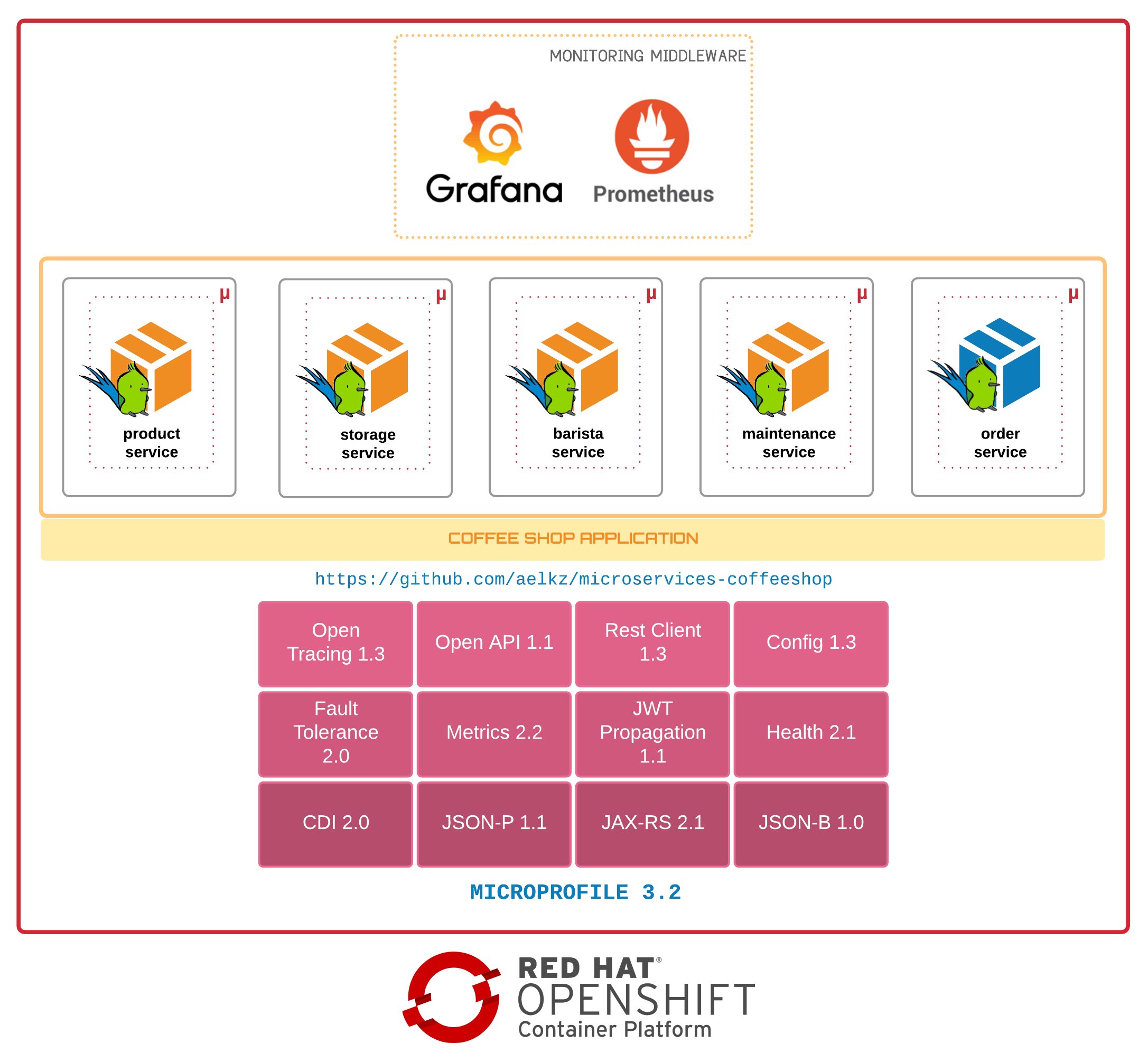
1-INIT
export USER=rabreu
export PROJECT_NS=microservices-coffeeshop
export OCP_HOST=mycloud.com
oc login -u $USER https://api.$OCP_HOST.com:6443
oc new-project $PROJECT_NS --description="Expert Extra Recording LAB" --display-name="microservices-coffeeshop"2-RED HAT REGISTRY SECRET CONFIGURATION
cat > config.json <<EOL
{
"auths": {
"registry.redhat.io": {
"auth": "YOUR-SECRET-KEY"
}
}
}
EOL2.1- Create a secret with your container credentials
oc delete secret redhat.io -n openshift
oc create secret generic "redhat.io" --from-file=.dockerconfigjson=config.json --type=kubernetes.io/dockerconfigjson -n $PROJECT_NS
oc secrets link default redhat.io --for=pull -n $PROJECT_NS
oc secrets link builder redhat.io -n $PROJECT_NS3-IMPORT OPENJDK-8-RHEL8 CONTAINER IMAGE
# option1
oc import-image openjdk/openjdk-8-rhel8 --from=registry.redhat.io/openjdk/openjdk-8-rhel8 --confirm -n $PROJECT_NS
oc import-image openjdk/openjdk-8-rhel8 --from=registry.redhat.io/openjdk/openjdk-8-rhel8 --confirm -n openshift
# option2 (working)
oc import-image redhat-openjdk-18/openjdk18-openshift --from=registry.redhat.io/redhat-openjdk-18/openjdk18-openshift --confirm -n openshift4-NEXUS OSS DEPLOYMENT
oc new-app --docker-image docker.io/sonatype/nexus3:latest
oc rollout pause dc/nexus3
oc patch dc nexus3 -p '{"spec":{"strategy":{"type":"Recreate"}}}'
oc expose svc nexus3
oc set resources dc nexus3 --limits=memory=4Gi,cpu=2 --requests=memory=2Gi,cpu=500m
oc set volume dc/nexus3 --add --overwrite --name=nexus3-volume-1 --mount-path=/nexus-data/ --type persistentVolumeClaim --claim-name=nexus-pvc --claim-size=10Gi
oc set probe dc/nexus3 --liveness --failure-threshold 3 --initial-delay-seconds 60 -- echo ok
oc set probe dc/nexus3 --readiness --failure-threshold 3 --initial-delay-seconds 60 --get-url=http://:8081/
oc rollout resume dc nexus3
NEXUS_POD=$(oc get pods --selector deploymentconfig=nexus3 -n $PROJECT_NS | { read line1 ; read line2 ; echo "$line2" ; } | awk '{print $1;}')
oc exec $NEXUS_POD cat /nexus-data/admin.password
# It will print the password. Something like:
# 33456b65-7e85-4dfc-a063-78b413cf4a47
echo http://$(oc get route -n ${PROJECT_NS} | grep nexus3 | awk '{print $2;}')/
# log into the nexus and change password to admin123 (also enable: Enable anonymous access)
# then, download the shell script bellow:
curl -o setup_nexus3.sh -s https://raw.githubusercontent.com/aelkz/microservices-coffeeshop/master/_configuration/nexus/setup_nexus3.sh
chmod +x setup_nexus3.sh
./setup_nexus3.sh admin admin123 http://$(oc get route -n ${PROJECT_NS} nexus3 --template='{{ .spec.host }}')
oc expose dc nexus3 --port=5000 --name=nexus-registry -n ${PROJECT_NS}
oc create route edge nexus-registry --service=nexus-registry --port=5000 -n ${PROJECT_NS}
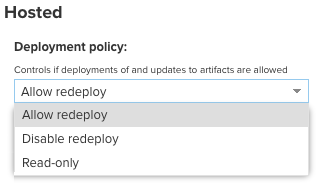
OBS.: You might want to add the jboss.org repository and add to maven-group and maven-public repositories on nexus:
See: parent project pom.xml for details on <repositories> tag.
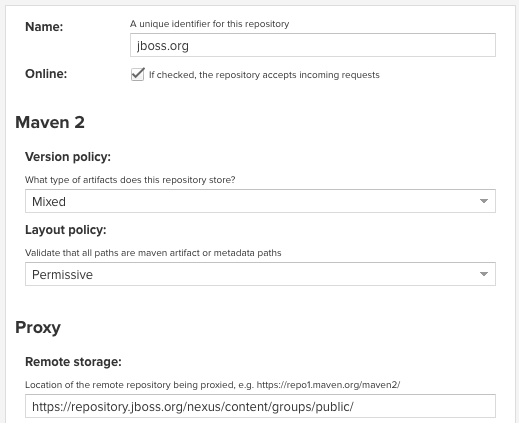
5-NEXUS ENVIRONMENT VARIABLES
# download maven settings.xml file
curl -o maven-settings-template.xml -s https://raw.githubusercontent.com/aelkz/microservices-coffeeshop/master/_configuration/nexus/maven-settings-template.xml
# change mirror url using your nexus openshift route
export MAVEN_URL=http://$(oc get route -n ${PROJECT_NS} nexus3 --template='{{ .spec.host }}')/repository/maven-group/
export MAVEN_URL_RELEASES=http://$(oc get route -n ${PROJECT_NS} nexus3 --template='{{ .spec.host }}')/repository/maven-releases/
export MAVEN_URL_SNAPSHOTS=http://$(oc get route -n ${PROJECT_NS} nexus3 --template='{{ .spec.host }}')/repository/maven-snapshots/
awk -v path="$MAVEN_URL" '/<url>/{sub(/>.*</,">"path"<")}1' maven-settings-template.xml > maven-settings.xml
rm -fr maven-settings-template.xml6-APPLICATION DEPLOYMENT – PARENT PROJECT
# deploy parent project on nexus
git clone https://github.com/aelkz/microservices-coffeeshop.git
mvn clean package deploy -DnexusReleaseRepoUrl=$MAVEN_URL_RELEASES -DnexusSnapshotRepoUrl=$MAVEN_URL_SNAPSHOTS -s ./maven-settings.xml -e -X -N7-APPLICATION DEPLOYMENT – BARISTA THORNTAIL APPLICATION
export APP_NAME=barista
export THORNTAIL_APP=$APP_NAME-service
# oc delete all -lapp=$APP_NAME-service -n $PROJECT_NS
# oc delete is $APP_NAME-service -n $PROJECT_NS
# oc delete bc $APP_NAME-service-s2i -n $PROJECT_NS
# oc delete is $APP_NAME-service -n $PROJECT_NSPrefered Option (using a source strategy build):
oc new-app openjdk18-openshift:latest~https://github.com/aelkz/microservices-coffeeshop.git --name=$THORNTAIL_APP --context-dir=/$APP_NAME-service --build-env='MAVEN_MIRROR_URL='${MAVEN_URL} -e MAVEN_MIRROR_URL=${MAVEN_URL} -n ${PROJECT_NS}8-CONFIGURE APP RESOURCES
oc tag $APP_NAME-service:1.0 $APP_NAME-service:latest -n ${PROJECT_NS}
oc set resources dc $THORNTAIL_APP --requests=cpu=500m,memory=500Mi --limits=cpu=750m,memory=1Gi -n ${PROJECT_NS}
oc set env dc/$THORNTAIL_APP JAVA_DEBUG=true -n ${PROJECT_NS}
oc set env dc/$THORNTAIL_APP GC_MAX_METASPACE_SIZE=256 -n ${PROJECT_NS}9-CONFIGURE APP PRODUCTION ENVIRONMENT
oc delete configmap $APP_NAME-config-file -n ${PROJECT_NS}
oc create -f ../_configuration/openshift/$APP_NAME-config/production.yaml -n ${PROJECT_NS}
oc set volume dc/$APP_NAME-service --remove --name=$APP_NAME-config-volume -n ${PROJECT_NS}
oc set volume dc/$APP_NAME-service --add --overwrite --name=$APP_NAME-config-volume -m /app/config -t configmap --configmap-name=$APP_NAME-config-file -n ${PROJECT_NS}
oc set env dc/$APP_NAME-service JAVA_OPTIONS="-server -Djava.net.preferIPv4Stack=true -Dswarm.project.stage=production -Dthorntail.project.stage.file=file:///app/config/$APP_NAME-config.yml"10-EXPOSE APP ROUTE
oc expose svc/$APP_NAME-service -n ${PROJECT_NS}TEST!
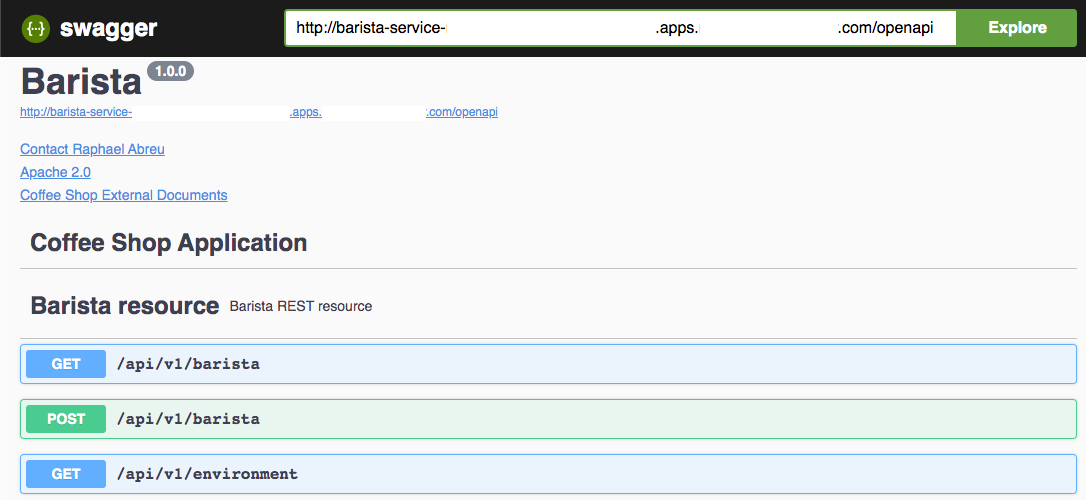
11-APPLICATION DEPLOYMENT – PRODUCT THORNTAIL APPLICATION
APP_NAME=product
THORNTAIL_APP=$APP_NAME-service
# oc delete all -lapp=$APP_NAME-service -n $PROJECT_NS
# oc delete is $APP_NAME-service -n $PROJECT_NS
# oc delete bc $APP_NAME-service-s2i -n $PROJECT_NS
# oc delete is $APP_NAME-service -n $PROJECT_NS
oc new-app openjdk18-openshift:latest~https://github.com/aelkz/microservices-coffeeshop.git --name=$THORNTAIL_APP --context-dir=/$APP_NAME-service --build-env='MAVEN_MIRROR_URL='${MAVEN_URL} -e MAVEN_MIRROR_URL=${MAVEN_URL} -n ${PROJECT_NS}
oc tag $APP_NAME-service:1.0 $APP_NAME-service:latest -n ${PROJECT_NS}
oc set resources dc $THORNTAIL_APP --requests=cpu=500m,memory=500Mi --limits=cpu=750m,memory=1Gi -n ${PROJECT_NS}
oc set env dc/$THORNTAIL_APP GC_MAX_METASPACE_SIZE=256 -n ${PROJECT_NS}
oc expose svc/$APP_NAME-service -n ${PROJECT_NS}12-APPLICATION DEPLOYMENT – STORAGE THORNTAIL APPLICATION
APP_NAME=storage
THORNTAIL_APP=$APP_NAME-service
# oc delete all -lapp=$APP_NAME-service -n $PROJECT_NS
# oc delete is $APP_NAME-service -n $PROJECT_NS
# oc delete bc $APP_NAME-service-s2i -n $PROJECT_NS
# oc delete is $APP_NAME-service -n $PROJECT_NS
oc new-app openjdk18-openshift:latest~https://github.com/aelkz/microservices-coffeeshop.git --name=$THORNTAIL_APP --context-dir=/$APP_NAME-service --build-env='MAVEN_MIRROR_URL='${MAVEN_URL} -e MAVEN_MIRROR_URL=${MAVEN_URL} -n ${PROJECT_NS}
oc tag $APP_NAME-service:1.0 $APP_NAME-service:latest -n ${PROJECT_NS}
oc set resources dc $THORNTAIL_APP --requests=cpu=500m,memory=500Mi --limits=cpu=750m,memory=1Gi -n ${PROJECT_NS}
oc set env dc/$THORNTAIL_APP GC_MAX_METASPACE_SIZE=256 -n ${PROJECT_NS}
oc expose svc/$APP_NAME-service -n ${PROJECT_NS}13-APPLICATION DEPLOYMENT – MAINTENANCE THORNTAIL APPLICATION
APP_NAME=maintenance
THORNTAIL_APP=$APP_NAME-service
# oc delete all -lapp=$APP_NAME-service -n $PROJECT_NS
# oc delete is $APP_NAME-service -n $PROJECT_NS
# oc delete bc $APP_NAME-service-s2i -n $PROJECT_NS
# oc delete is $APP_NAME-service -n $PROJECT_NS
oc new-app openjdk18-openshift:latest~https://github.com/aelkz/microservices-coffeeshop.git --name=$THORNTAIL_APP --context-dir=/$APP_NAME-service --build-env='MAVEN_MIRROR_URL='${MAVEN_URL} -e MAVEN_MIRROR_URL=${MAVEN_URL} -n ${PROJECT_NS}
oc tag $APP_NAME-service:1.0 $APP_NAME-service:latest -n ${PROJECT_NS}
oc set resources dc $THORNTAIL_APP --requests=cpu=500m,memory=500Mi --limits=cpu=750m,memory=1Gi -n ${PROJECT_NS}
oc set env dc/$THORNTAIL_APP GC_MAX_METASPACE_SIZE=256 -n ${PROJECT_NS}
oc expose svc/$APP_NAME-service -n ${PROJECT_NS}14-APPLICATION DEPLOYMENT – ORDER THORNTAIL APPLICATION
APP_NAME=order
THORNTAIL_APP=$APP_NAME-service
# oc delete all -lapp=$APP_NAME-service -n $PROJECT_NS
# oc delete is $APP_NAME-service -n $PROJECT_NS
# oc delete bc $APP_NAME-service-s2i -n $PROJECT_NS
# oc delete is $APP_NAME-service -n $PROJECT_NS
oc new-app openjdk18-openshift:latest~https://github.com/aelkz/microservices-coffeeshop.git --name=$THORNTAIL_APP --context-dir=/$APP_NAME-service --build-env='MAVEN_MIRROR_URL='${MAVEN_URL} -e MAVEN_MIRROR_URL=${MAVEN_URL} -n ${PROJECT_NS}
oc tag $APP_NAME-service:1.0 $APP_NAME-service:latest -n ${PROJECT_NS}
oc set resources dc $THORNTAIL_APP --requests=cpu=500m,memory=500Mi --limits=cpu=750m,memory=1Gi -n ${PROJECT_NS}
oc set env dc/$THORNTAIL_APP GC_MAX_METASPACE_SIZE=256 -n ${PROJECT_NS}
APP_NAME=order
BARISTA_ROUTE=http://barista-service.${PROJECT_NS}.svc.cluster.local:8080/api/v1
MAINTENANCE_ROUTE=http://maintenance-service.${PROJECT_NS}.svc.cluster.local:8080/api/v1
PRODUCT_ROUTE=http://product-service.${PROJECT_NS}.svc.cluster.local:8080/api/v1
STORAGE_ROUTE=http://storage-service.${PROJECT_NS}.svc.cluster.local:8080/api/v1
echo "
apiVersion: v1
kind: ConfigMap
metadata:
name: order-config-file
data:
order-config.yml: |-
project:
stage: production
thorntail:
logging: INFO
ajp:
enable: true
http:
port: 8080
datasources:
data-sources:
OrderDS:
driver-name: h2
connection-url: jdbc:h2:mem:order;DB_CLOSE_DELAY=-1;DB_CLOSE_ON_EXIT=FALSE
user-name: sa
password: sa
greeting:
message: Hello %s from order-configmap.yml!
coffeeshop:
routes:
barista-service: \""$BARISTA_ROUTE"\"
maintenance-service: \""$MAINTENANCE_ROUTE\""
product-service: \""$PRODUCT_ROUTE\""
storage-service: \""$STORAGE_ROUTE\""
" > production.yaml
oc delete configmap $APP_NAME-config-file -n ${PROJECT_NS}
oc create -f production.yaml -n ${PROJECT_NS}
# oc set volume dc/$APP_NAME-service --remove --name=$APP_NAME-config-volume -n ${PROJECT_NS}
oc set volume dc/$APP_NAME-service --add --overwrite --name=$APP_NAME-config-volume -m /app/config -t configmap --configmap-name=$APP_NAME-config-file -n ${PROJECT_NS}
oc set env dc/$APP_NAME-service JAVA_OPTIONS="-server -Djava.net.preferIPv4Stack=true -Dswarm.project.stage=production -Dthorntail.project.stage.file=file:///app/config/$APP_NAME-config.yml"
oc expose svc/$APP_NAME-service -n ${PROJECT_NS}15-PROMETHEUS DEPLOYMENT
All microprofile applications enable by default the following endpoints:
http://localhost:8080/metrics (all metrics)
http://localhost:8080/metrics/application (exclusively for application-level metrics)
echo "
apiVersion: monitoring.coreos.com/v1
kind: ServiceMonitor
metadata:
name: thorntail-prometheus-monitor
labels:
k8s-app: prometheus
namespace: "$PROJECT_NS"
spec:
namespaceSelector:
matchNames:
- "$PROJECT_NS"
selector:
matchLabels:
monitor: thorntail-app
endpoints:
- port: http
interval: 15s
path: '/metrics'
" echo "
apiVersion: monitoring.coreos.com/v1
kind: Prometheus
metadata:
name: server
labels:
prometheus: k8s
namespace: "$PROJECT_NS"
spec:
replicas: 2
serviceAccountName: prometheus-k8s
securityContext: {}
serviceMonitorSelector:
matchExpressions:
- key: k8s-app
operator: Exists
ruleSelector:
matchLabels:
role: prometheus-rulefiles
prometheus: k8s
alerting:
alertmanagers:
- namespace: "$PROJECT_NS"
name: alertmanager-main
port: web
" Expose prometheus route:
oc expose svc prometheus-operated -n $PROJECT_NS
16-GRAFANA DEPLOYMENT
Follow these instructions:
https://www.redhat.com/en/blog/custom-grafana-dashboards-red-hat-openshift-container-platform-4
https://github.com/integr8ly/application-monitoring-operator/blob/master/scripts/install.sh
https://medium.com/@zhimin.wen/grafana-dashboard-in-ocp4-2-44468e5390d0
https://operatorhub.io/operator/grafana-operator
Grafana operator template:
echo "
apiVersion: integreatly.org/v1alpha1
kind: Grafana
metadata:
name: grafana
namespace: "$PROJECT_NS"
spec:
ingress:
enabled: true
config:
auth.anonymous:
enabled: true
log:
level: warn
mode: console
security:
admin_password: "123456"
admin_user: "grafana"
auth:
disable_login_form: false
disable_signout_menu: true
dashboardLabelSelector:
- matchExpressions:
- key: app
operator: In
values:
- grafana
"You can also deploy the objects manually:
git clone https://github.com/integr8ly/grafana-operator.git
cd grafana-operator
oc create -f deploy/crds -n ${PROJECT_NS}
oc create -f deploy/roles -n ${PROJECT_NS}
oc create -f deploy/cluster_roles -n ${PROJECT_NS}
oc create -f deploy/operator.yaml -n ${PROJECT_NS}OBS. Grafana can be deployed with a oauth-proxy sidecard.
In order to access grafana, you’ll need access using some service-account and/or cluster admin.
Acquire grafana’s route
echo http://$(oc get route grafana -n ${PROJECT_NS} --template='{{ .spec.host }}')Acquire prometheus route
echo http://prometheus-operated.$PROJECT_NS.svc.cluster.local:9090Grafana should be configurated to use the Prometheus datasouce:
URL= http://prometheus-operated.<YOUR-NAMESPACE>.svc.cluster.local:9090
Scrape Interval=5s
Query Timeout=30sApply and save. Check if the connection was successful:

APPLY PROMETHEUS LABELS
This will add the prometheus label, to enable scrapping on all services as defined in the step 15.
We will update all services and routes, changing from this:

To this:

oc label svc barista-service monitor=thorntail-app -n $PROJECT_NS
oc patch svc barista-service -p '{"spec":{"ports":[{"name":"http","port":8080,"protocol":"TCP","targetPort":8080}]}}' -n $PROJECT_NS
oc patch route barista-service -p '{"spec":{"port":{"targetPort":"http"}}}' -n $PROJECT_NS
oc label svc maintenance-service monitor=thorntail-app -n $PROJECT_NS
oc patch svc maintenance-service -p '{"spec":{"ports":[{"name":"http","port":8080,"protocol":"TCP","targetPort":8080}]}}' -n $PROJECT_NS
oc patch route maintenance-service -p '{"spec":{"port":{"targetPort":"http"}}}' -n $PROJECT_NS
oc label svc product-service monitor=thorntail-app -n $PROJECT_NS
oc patch svc product-service -p '{"spec":{"ports":[{"name":"http","port":8080,"protocol":"TCP","targetPort":8080}]}}' -n $PROJECT_NS
oc patch route product-service -p '{"spec":{"port":{"targetPort":"http"}}}' -n $PROJECT_NS
oc label svc storage-service monitor=thorntail-app -n $PROJECT_NS
oc patch svc storage-service -p '{"spec":{"ports":[{"name":"http","port":8080,"protocol":"TCP","targetPort":8080}]}}' -n $PROJECT_NS
oc patch route storage-service -p '{"spec":{"port":{"targetPort":"http"}}}' -n $PROJECT_NS
oc label svc order-service monitor=thorntail-app -n $PROJECT_NS
oc patch svc order-service -p '{"spec":{"ports":[{"name":"http","port":8080,"protocol":"TCP","targetPort":8080}]}}' -n $PROJECT_NS
oc patch route order-service -p '{"spec":{"port":{"targetPort":"http"}}}' -n $PROJECT_NSAfter this, you can check creation of all service targets on prometheus:
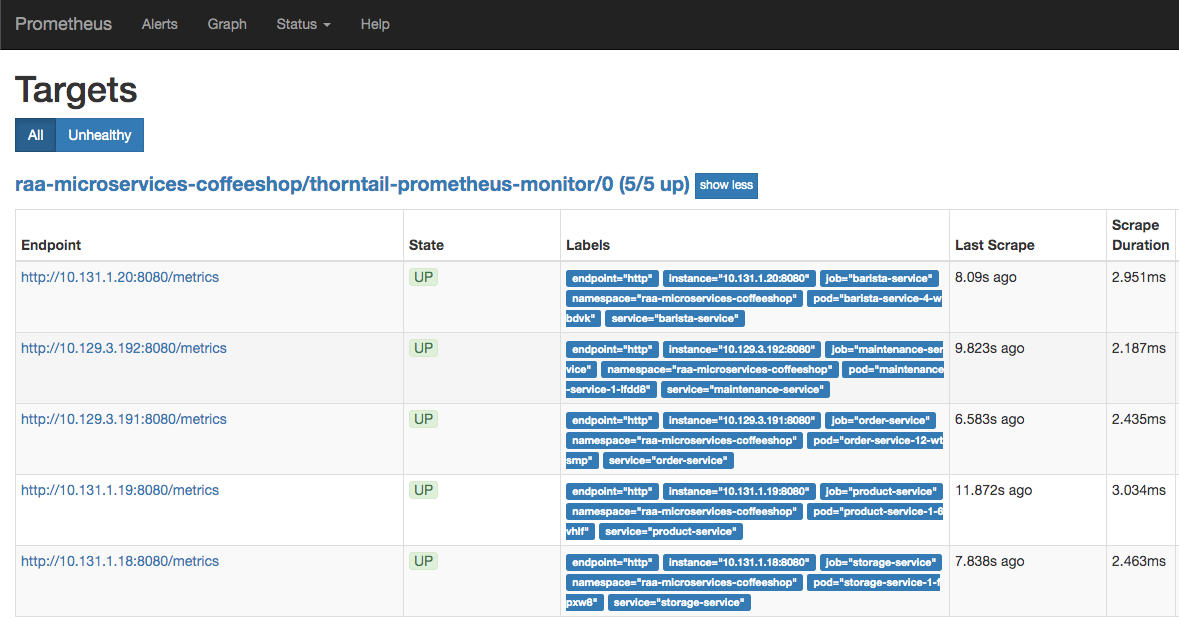
TEST USING REST HTTP CALLS
Open your Rest client application and try to create some records.
You’ll see the final result being updated uppon grafana dashboard.
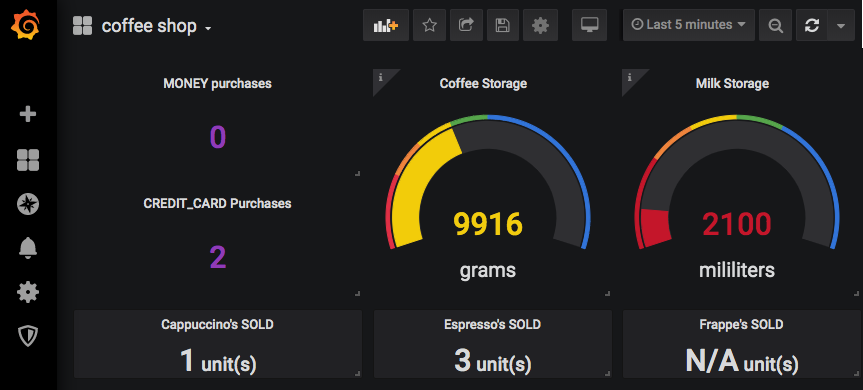
![]()